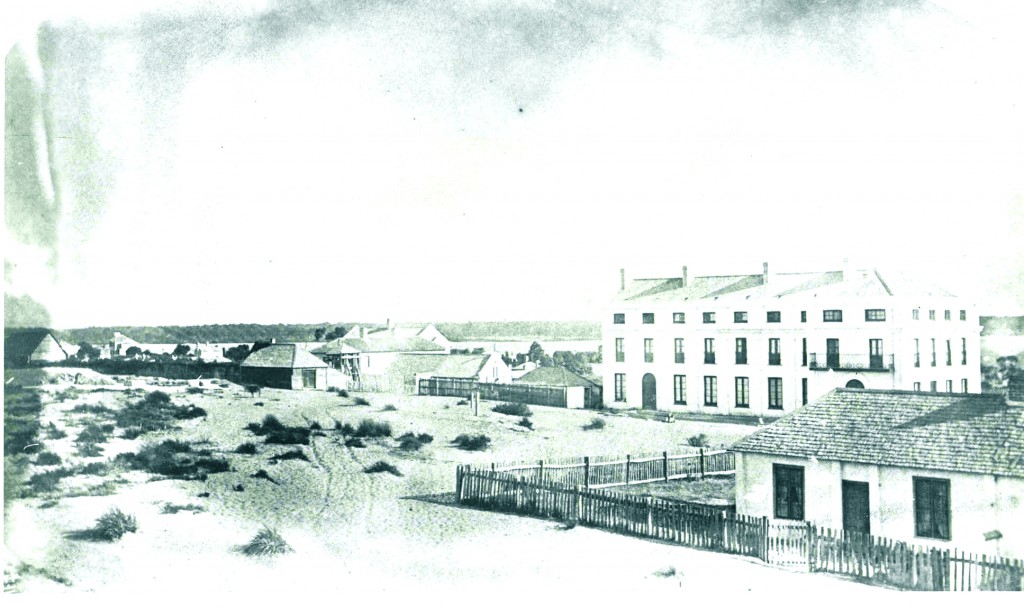
By Hal Colebatch
Construction of Perth’s first cathedral began on 27 December 1843. It was originally a chapel, school house and dwelling.
The chapel was designated a cathedral on 6 May 1845, on the elevation of Bishop Brady to the episcopate.
By the time Brady returned to the Swan River Colony on 7 January, bringing with him 27 missionaries, Perth’s first cathedral was still in a most primitive condition, without floorboards and the roof open to the sky.
It is perhaps not surprising that it was the indomitable Dom Salvado who nailed down the floorboards and fixed sheets of calico to the ceiling to keep out the weather.
After two years’ work among Aboriginal people in the Moore River area, Serra returned to Rome in 1848. Later that year, he was sent back to Perth with the title of Coadjutor with right of succession and Administrator Apostolic in temporalibus to help Brady govern the diocese.
Shortly after this, Perth’s Catholic population grew considerably as a result of the introduction of convicts, the Enrolled Pensioner Guard, and a number of free Irish immigrants. This meant an increase in Catholic numbers from 337 in 1848 to 2,034 in 1854.
Bishop Serra was now in charge and the increased numbers meant an expanded need for churches and schools.
An episcopal palace was built in Perth, completed in 1856. According to Sr Frances Stibi’s research, it seems 33 monks worked on the building.
In 1859, following a petition to the governor by Bishop Serra, the Victoria Square site was ceded to the Catholic Church, 10 years after Brady had first requested from Governor Charles Fitzgerald land adjoining Church Hill and Lord Street for a new church, school house and clergyman’s residence (the site of the present palace).
The bishop wrote: “I have the honour to request the attention of His Excellency the Governor to the necessity that exists of erecting a new church in the city for the members of the Catholic faith, their present place of worship being entirely inadequate for their accommodation, and to express my hope that His Excellency may be pleased to grant a suitable site for the intended church. On looking over the map of the city I find there is a reserve marked Victoria Square at the disposal of the Government which from its situation and proximity to our church property would in every way be acceptable to us; and as the church I intend to erect will be large and expensive it would, I believe, in this position serve to the embellishment of the city”.
The land was granted a few months later, the governor signing the grant in the name of Queen Victoria. The grant was received by Fr Martin Griver.
In Italy, Bishop Serra set about gathering donations and materials to embellish the interior of the cathedral.
The Benedictines at the Monastery of St Paul’s Outside the Walls donated marble for the altar. King Francis II of Naples granted 1,000 scudi, and ordered “an iron fence to enclose the whole of the land whereupon the Cathedral is to be built – more than 2,500 feet long – should be made at his expense at the royal iron foundry” (though there is no evidence that the fence ever actually arrived in Perth).
Serra wrote from Rome in February 1861 to the anxious Fr Griver: “Courage… the main altar will be boxed in a few days and will help you forget all the troubles you have gone through when you see it”. It arrived in July 1862.
In 1862, Griver took over as apostolic administrator. He set about the great task of building a worthy cathedral with zeal and determination.
He begged from Catholics and – with the help of one of his senior priests, Matthew Gibney – from Protestants and he begged money from the colonial government, arguing that the cathedral would be an ornament to the whole town. He received only £100.
In January 1863, Griver convened a meeting of the Catholic community in Perth at which it was decided to commence work on the cathedral immediately because there were now funds in hand.
Griver wrote to Salvado at New Norcia asking him to lay the foundation stone (see box above).